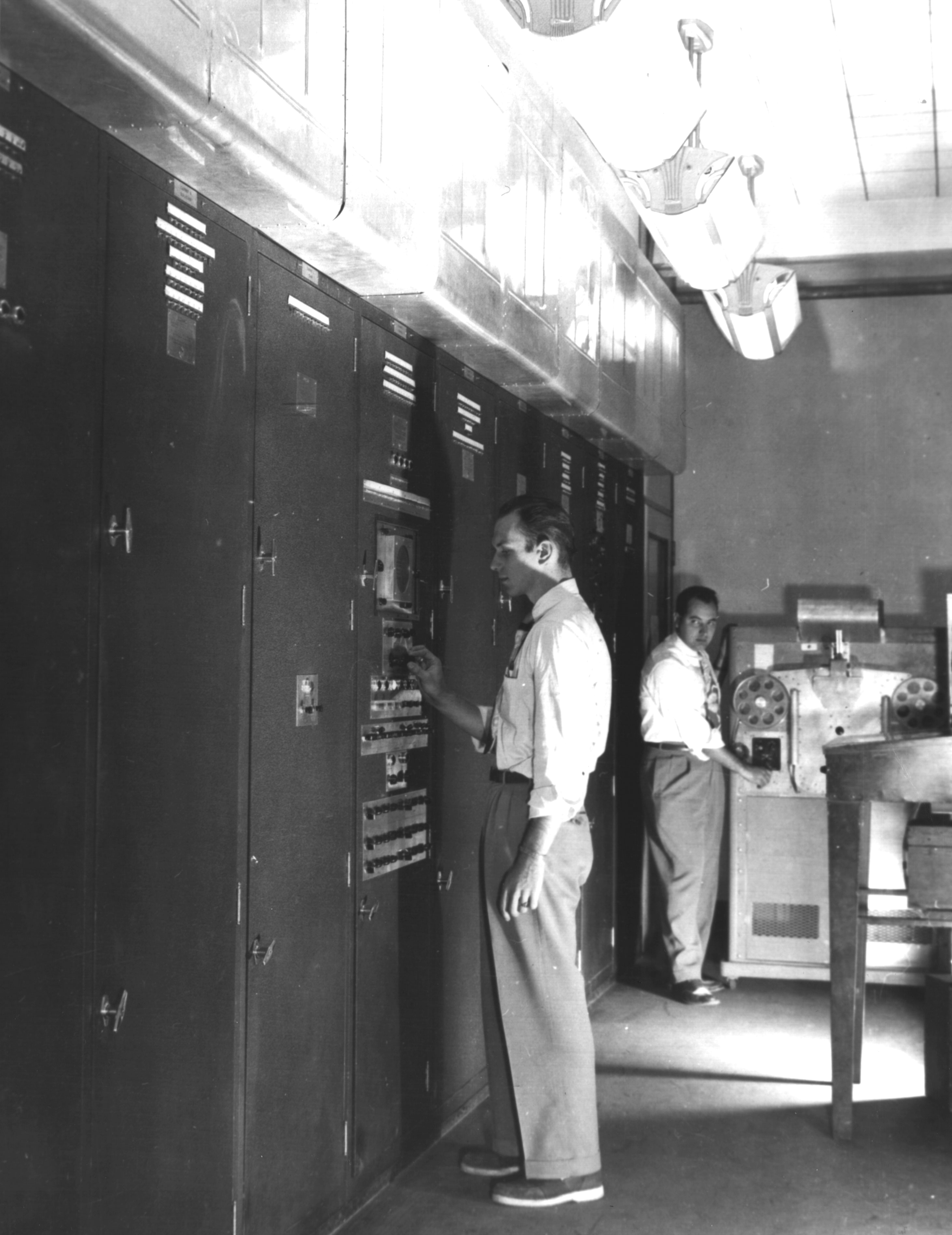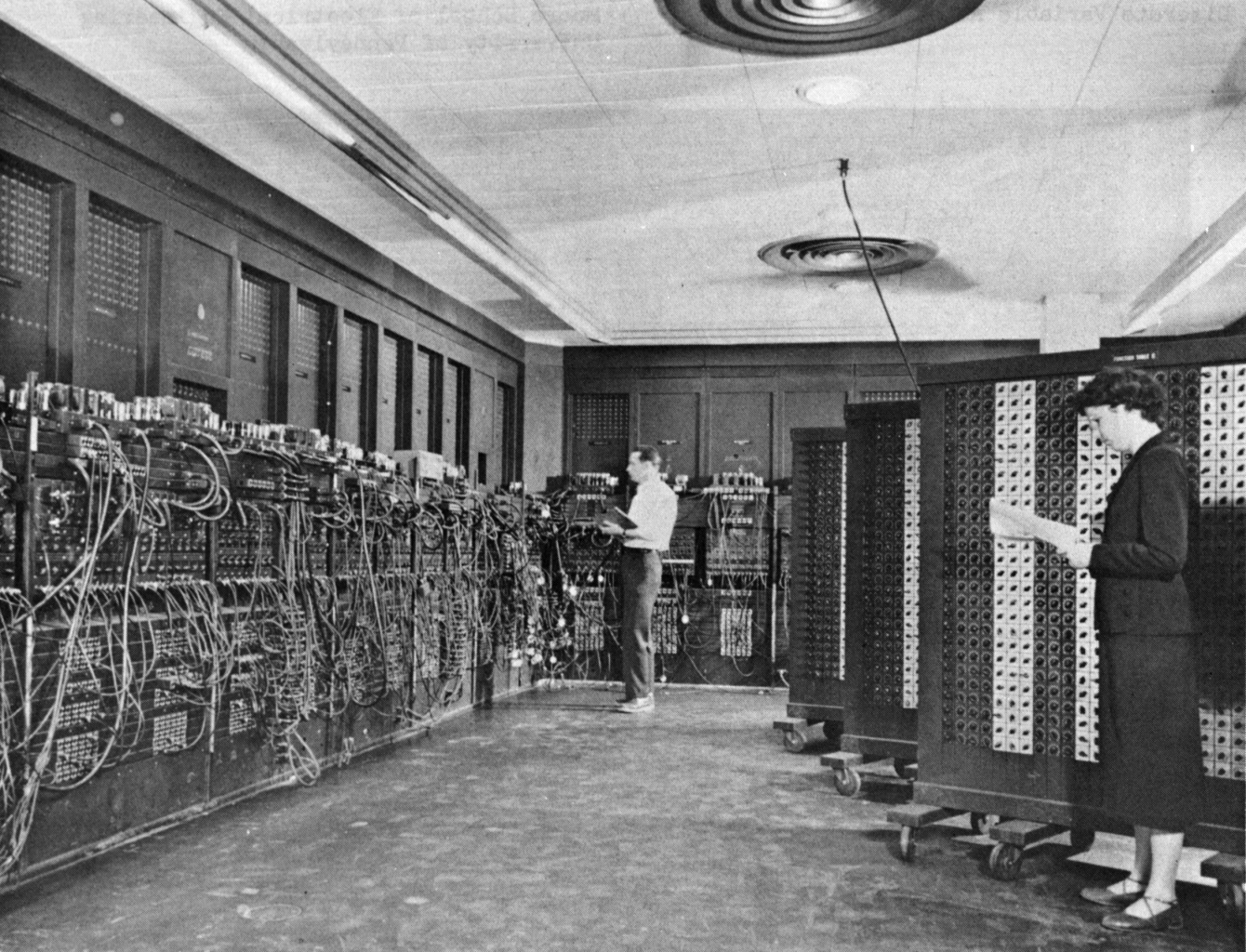|
EDVAC
EDVAC (Electronic Discrete Variable Automatic Computer) was one of the earliest electronic computers. It was built by Moore School of Electrical Engineering at the University of Pennsylvania. Along with ORDVAC, it was a successor to the ENIAC. Unlike ENIAC, it was binary rather than decimal, and was designed to be a stored-program computer. ENIAC inventors, John Mauchly and J. Presper Eckert, proposed the EDVAC's construction in August 1945. A contract to build the new computer was signed in April 1946 with an initial budget of US$100,000. EDVAC was delivered to the Ballistic Research Laboratory in 1949. The Ballistic Research Laboratory became a part of the US Army Research Laboratory in 1952. Functionally, EDVAC was a binary serial computer with automatic addition, subtraction, multiplication, programmed division and automatic checking with an ultrasonic serial memory having a capacity of 1,024 44-bit words. EDVAC's average addition time was 864 microseconds and it ... [...More Info...] [...Related Items...] OR: [Wikipedia] [Google] [Baidu] |
First Draft Of A Report On The EDVAC
The ''First Draft of a Report on the EDVAC'' (commonly shortened to ''First Draft'') is an incomplete 101-page document written by John von Neumann and distributed on June 30, 1945 by Herman Goldstine, security officer on the classified ENIAC project. It contains the first published description of the logical design of a computer using the stored-program concept, which has come to be known as the von Neumann architecture; the name has become controversial due to von Neumann's failure to name other contributors. History Von Neumann wrote the report by hand while commuting by train to Los Alamos, New Mexico and mailed the handwritten notes back to Philadelphia. Goldstine had the report typed and duplicated. While the date on the typed report is June 30, 24 copies of the ''First Draft'' were distributed to persons closely connected with the EDVAC project five days earlier on June 25. Interest in the report caused it to be sent all over the world; Maurice Wilkes of Cambridge ... [...More Info...] [...Related Items...] OR: [Wikipedia] [Google] [Baidu] |
Ballistic Research Laboratory
The Ballistic Research Laboratory (BRL) was a research facility under the U.S. Army Ordnance Corps and later the U.S. Army Materiel Command that specialized in ballistics as well as vulnerability and lethality analysis. Situated at Aberdeen Proving Ground, Maryland, BRL served as a major Army center for research and development in technologies related to weapon phenomena, armor, accelerator physics, and high-speed computing. In 1992, BRL was disestablished, and its mission, personnel, and facilities were incorporated into the newly created U.S. Army Research Laboratory (ARL). The laboratory is perhaps best known for commissioning the creation of the Electronic Numerical Integrator and Computer (ENIAC), the first electronic general-purpose digital computer. History Formation The history of the Ballistic Research Laboratory dates back to World War I with the Office of the Chief of Ordnance (OCO) within the U.S. Army. During the first year of U.S. involvement in the war, OCO w ... [...More Info...] [...Related Items...] OR: [Wikipedia] [Google] [Baidu] |
Moore School Lectures
''Theory and Techniques for Design of Electronic Digital Computers'' (popularly called the "Moore School Lectures") was a course in the construction of electronic digital computers held at the University of Pennsylvania's Moore School of Electrical Engineering between July 8, 1946, and August 30, 1946, and was the first time any computer topics had ever been taught to an assemblage of people. The course disseminated the ideas developed for the EDVAC (then being built at the Moore School as the successor computer to the ENIAC) and initiated an explosion of computer construction activity in the United States and internationally, especially in the United Kingdom. Background The Moore School in Philadelphia, Pennsylvania was at the center of developments in high-speed electronic computing in 1946. On February 14 of that year it had publicly unveiled the ENIAC, the first general-purpose electronic digital computer, developed in secret beginning in 1943 for the Army's Ballistics Rese ... [...More Info...] [...Related Items...] OR: [Wikipedia] [Google] [Baidu] |
John Mauchly
John William Mauchly ( ; August 30, 1907 – January 8, 1980) was an American physicist who, along with J. Presper Eckert, designed ENIAC, the first general-purpose electronic digital computer, as well as EDVAC, BINAC and UNIVAC I, the first commercial computer made in the United States. Together, Mauchly and Eckert started the first computer company, the Eckert–Mauchly Computer Corporation (EMCC), which allowed them to further the development of fundamental computer concepts originally conceived by members of the 1945-46 ENIAC programming team, notably Jean Bartik and Kay McNulty, including subroutines, nesting, and the first low-level assembler. They also popularized the concept of the stored program, which was formalized in John von Neumann's widely-read '' First Draft of a Report on the EDVAC'' (1945) and disseminated through the Moore School Lectures (1946). These publications influenced an explosion of computer development around the world in the late 1940 ... [...More Info...] [...Related Items...] OR: [Wikipedia] [Google] [Baidu] |
ENIAC
ENIAC (; Electronic Numerical Integrator and Computer) was the first Computer programming, programmable, Electronics, electronic, general-purpose digital computer, completed in 1945. Other computers had some of these features, but ENIAC was the first to have them all. It was Turing-complete and able to solve "a large class of numerical problems" through reprogramming. ENIAC was designed by John Mauchly and J. Presper Eckert to calculate artillery external ballistics, firing tables for the United States Army's Ballistic Research Laboratory (which later became a part of the United States Army Research Laboratory, Army Research Laboratory). However, its first program was a study of the feasibility of the thermonuclear weapon. ENIAC was completed in 1945 and first put to work for practical purposes on December 10, 1945.* ENIAC was formally dedicated at the University of Pennsylvania on February 15, 1946, having cost $487,000 (), and called a "Giant Brain" by the press. It had ... [...More Info...] [...Related Items...] OR: [Wikipedia] [Google] [Baidu] |
Stored Program
A stored-program computer is a computer that stores program instructions in electronically, electromagnetically, or optically accessible memory. This contrasts with systems that stored the program instructions with plugboards or similar mechanisms. The definition is often extended with the requirement that the treatment of programs and data in memory be interchangeable or uniform. Description In principle, stored-program computers have been designed with various architectural characteristics. A computer with a von Neumann architecture stores program data and instruction data in the same memory, while a computer with a Harvard architecture has separate memories for storing program and data. However, the term ''stored-program computer'' is sometimes used as a synonym for the von Neumann architecture. Jack Copeland considers that it is "historically inappropriate, to refer to electronic stored-program digital computers as 'von Neumann machines. Hennessy and Patterson wrote tha ... [...More Info...] [...Related Items...] OR: [Wikipedia] [Google] [Baidu] |
Computer
A computer is a machine that can be Computer programming, programmed to automatically Execution (computing), carry out sequences of arithmetic or logical operations (''computation''). Modern digital electronic computers can perform generic sets of operations known as Computer program, ''programs'', which enable computers to perform a wide range of tasks. The term computer system may refer to a nominally complete computer that includes the Computer hardware, hardware, operating system, software, and peripheral equipment needed and used for full operation; or to a group of computers that are linked and function together, such as a computer network or computer cluster. A broad range of Programmable logic controller, industrial and Consumer electronics, consumer products use computers as control systems, including simple special-purpose devices like microwave ovens and remote controls, and factory devices like industrial robots. Computers are at the core of general-purpose devices ... [...More Info...] [...Related Items...] OR: [Wikipedia] [Google] [Baidu] |
John Von Neumann
John von Neumann ( ; ; December 28, 1903 – February 8, 1957) was a Hungarian and American mathematician, physicist, computer scientist and engineer. Von Neumann had perhaps the widest coverage of any mathematician of his time, integrating Basic research, pure and Applied science#Applied research, applied sciences and making major contributions to many fields, including mathematics, physics, economics, computing, and statistics. He was a pioneer in building the mathematical framework of quantum physics, in the development of functional analysis, and in game theory, introducing or codifying concepts including Cellular automaton, cellular automata, the Von Neumann universal constructor, universal constructor and the Computer, digital computer. His analysis of the structure of self-replication preceded the discovery of the structure of DNA. During World War II, von Neumann worked on the Manhattan Project. He developed the mathematical models behind the explosive lense ... [...More Info...] [...Related Items...] OR: [Wikipedia] [Google] [Baidu] |
Moore School Of Electrical Engineering
The Moore School of Electrical Engineering was a school at the University of Pennsylvania. The school was integrated into the University of Pennsylvania School of Engineering and Applied Science. The Moore School came into existence as a result of an endowment from Alfred Fitler Moore on June 4, 1923. It was granted to Penn's School of Electrical Engineering, located in the Towne Building. The first dean of the Moore School was Harold Pender. The Moore School is particularly famed as the birthplace of the computer industry: * It was here that the first general-purpose Turing complete digital electronic computer, the ENIAC, was built between 1943 and 1946. * Preliminary design work on the ENIAC's successor machine the EDVAC resulted in the stored program concept used in all computers today, the logical design having been promulgated in John von Neumann's ''First Draft of a Report on the EDVAC'', a set of notes synthesized from meetings he attended at the Moore School. * The ... [...More Info...] [...Related Items...] OR: [Wikipedia] [Google] [Baidu] |






